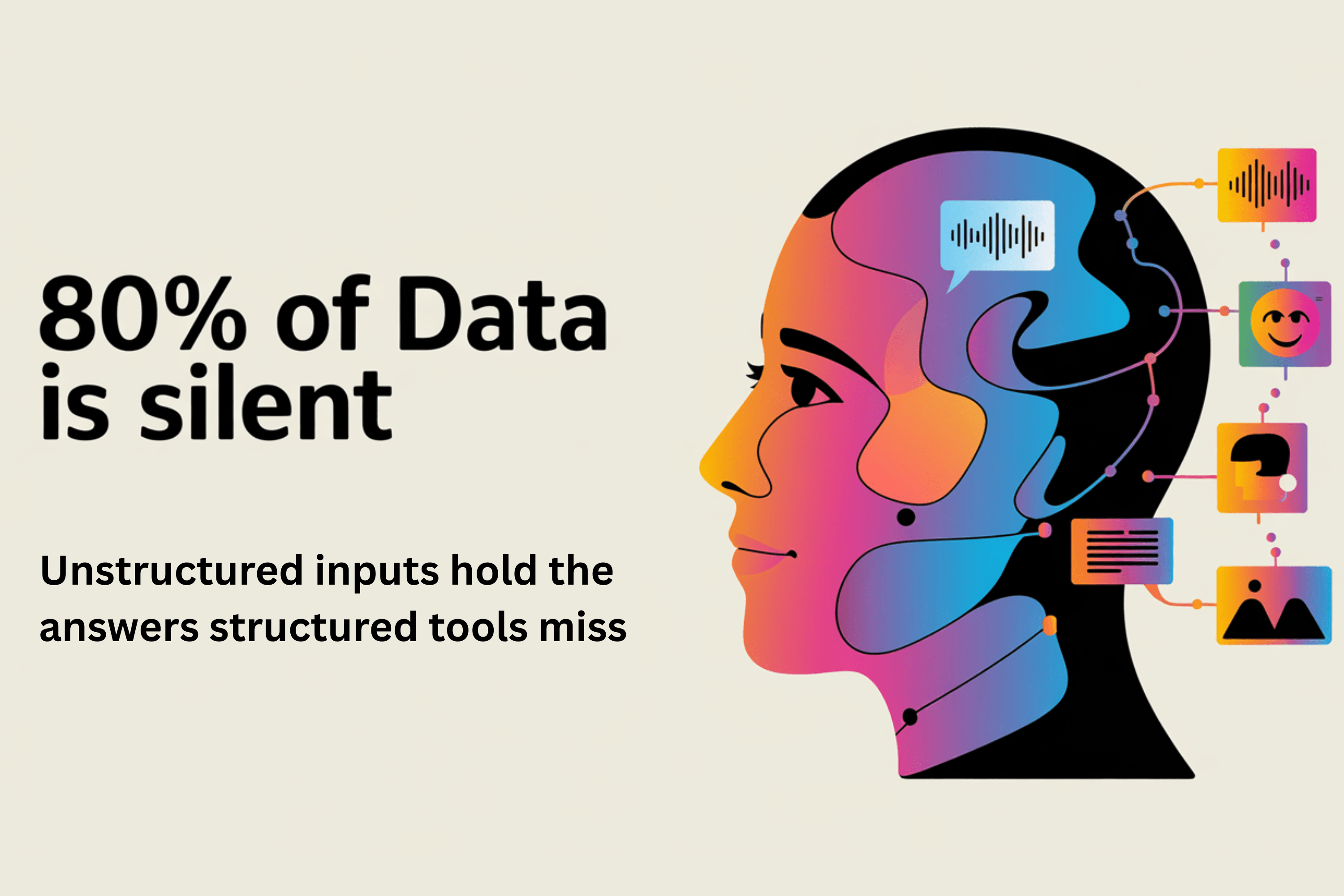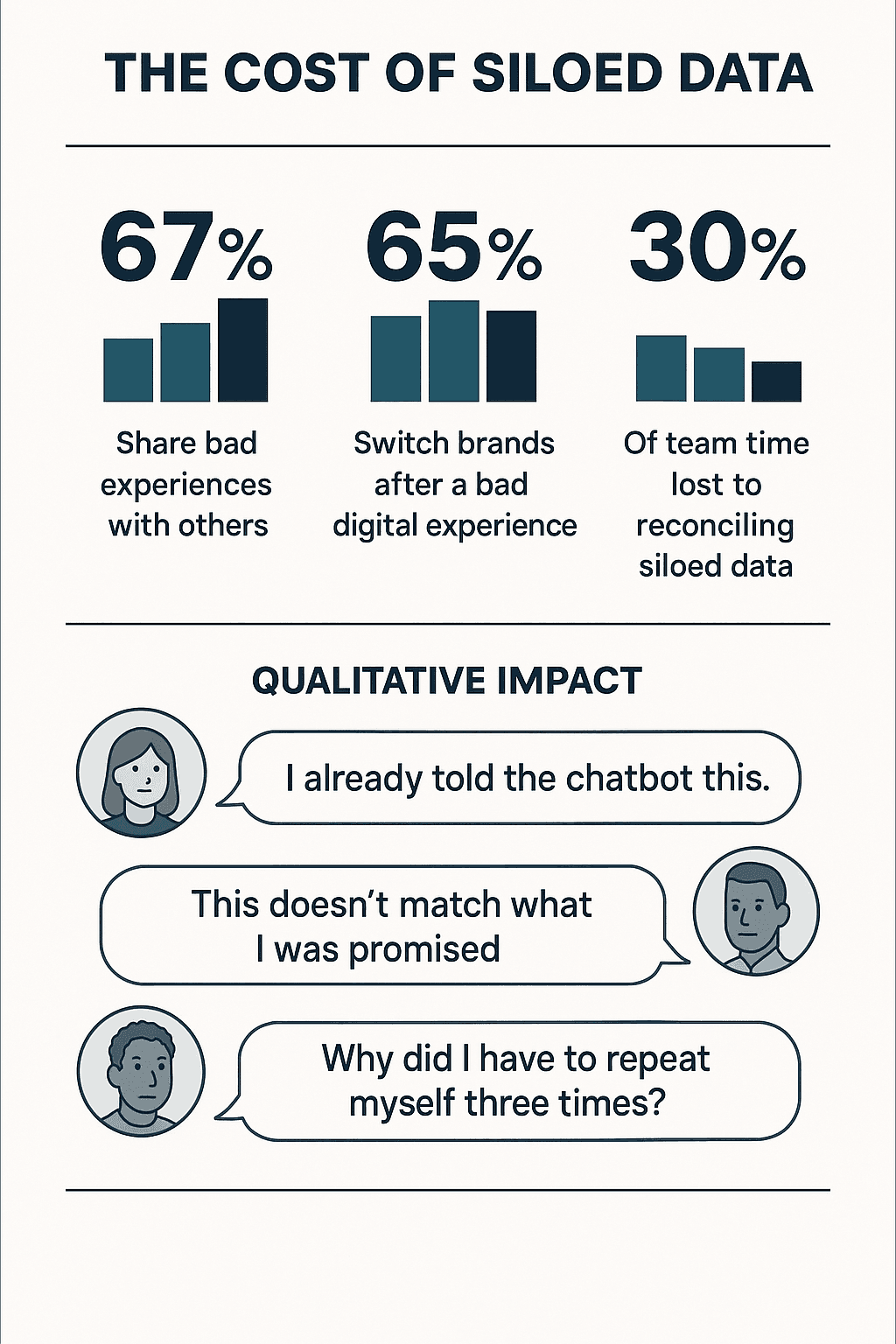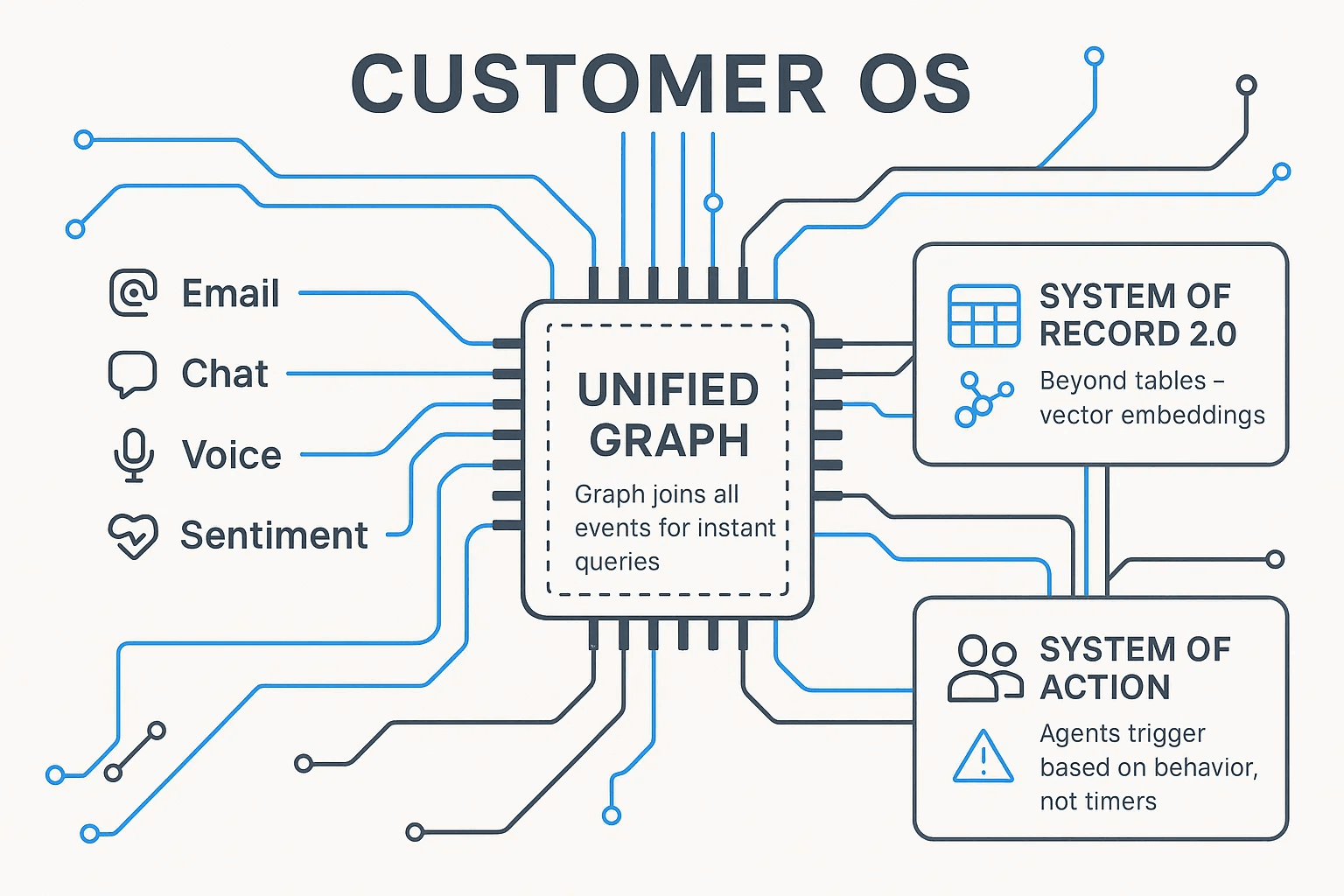Why Growth Teams Need an AI-Native Customer OS

From Linear Journeys to Fragmented Data Silos
Marketing technology has spent twenty years solving yesterday’s problem: how to push the right message to the right segment based on clicks and demographic look-ups. That worked when journeys were linear and channels were countable on one hand. Today a prospect might discover your brand in a TikTok comment, start a WhatsApp chat, bounce to your website, open an e-mail offer and finally sign a contract on a video call—all before lunchtime. Each hop sheds data, yet almost none of that data lands in one place. CRMs file the e-mail, analytics tools note the page view, the chat transcript sits in a vendor cloud, and the call recording disappears into a support vault. Nobody owns the whole movie.
The Cost of Disjointed Customer Experiences
The result is both familiar and costly: ops teams spend whole quarters reconciling spreadsheets, attribution models keep guessing, and customers receive disjointed experiences they describe as “frustrating” or “annoying.” In a recent Khoros survey 67 percent of customers said they share a bad digital experience with others, and 65 percent switch brands after it happens. Losing buyers for preventable reasons is bad in any economy; in 2025’s tight budgets it is unforgivable.

The Data Iceberg No One Wants to Talk About
Part of the problem hides below the surface. By 2025, an estimated 80 percent of the world’s data will be unstructured—chat, voice, emojis, free-form surveys, images, PDFs. Classic customer-data platforms were architected for structured events: an ORDER_PLACED, an EMAIL_OPENED, a PRODUCT_VIEWED. They have nowhere native to store “Customer hesitated for two beats before asking about pricing” or “Tone = mildly frustrated.” Instead, companies bolt on utilities: a sentiment API here, a call-analysis plug-in there. Each utility writes to its own silo, and the distance between tools becomes the distance between departments.
Operational Drag from Data Silos
The operational drag is measurable. Forbes Tech Council reports that data silos can consume up to 30 percent of staff time in reconciliation work. Chief Martec’s 2024 landscape shows 14,000-plus separate martech products vying for attention. Every new purchase promises “integration,” yet each also creates another log-in screen and another partial database. What teams need is not another utility but a unifying core—an operating system for customer information and action.
Defining the Customer OS
A Customer Operating System does for customer engagement what mobile OSes did for smartphones: it hides the plumbing and offers reusable building blocks (primitives) that anyone can combine. Those primitives fall into two categories.

System of Record 2.0
Traditional tables (orders, contacts, segments) coexist with vector stores that hold long-form chat, voice embeddings, image tags and the chain-of-thought of autonomous agents. Both data types share keys so a query can join them instantly.
System of Action
Instead of dripping e-mails on a timer, the OS exposes autonomous agents that observe the graph, reason and act. If a lead’s status flips to “Dormant > 90 days,” a nurture agent spins up without waiting for a marketer to schedule a campaign. When the customer replies, a qualification agent decides whether to escalate, tag churn risk or trigger an outbound call.
Continuous End-to-End Visibility
Together these primitives offer something point tools cannot: continuous end-to-end visibility. Omnichannel engagement and seamless automation are no longer modules to buy; they are emergent behaviours of the underlying graph and agent layer.
Interoperability Across the Agentic Universe
Because agents need to talk to each other, industry groups are coalescing around lightweight protocols such as MCP (Message-Passing Conversation Protocol) and A2A (Agent-to-Agent) exchanges. Think of MCP as HTTP for autonomous workflows: Agent A publishes an intent packet to the graph, Agent B subscribes and replies with a recommended action or hands off to Agent C. Everything is timestamped and queryable. Workflow designers don’t draw if/else branches; they assemble agent roles that negotiate outcomes.
Structured and Unstructured Data in a Single Ledger
Analysts often separate quantitative and qualitative analytics as if they were different sports. In practice, insights emerge when you can blend them:
“Show me prospects who have viewed the pricing page twice (structured) and sound confused about plan tiers in chat (unstructured).”
“List customers whose average sentiment has fallen by two points since their last order.”
With all events—clicks, tones, intents—written to one graph, such questions run in milliseconds. Marketing, sales and service teams stop arguing over whose dashboard is “truer” because they share a ledger.
Experience First, Plumbing Second
Why invest in architecture at all? Because the customer feels the seams. Zendesk data shows that 73 percent will leave after multiple disjointed interactions. The Customer OS is not an IT vanity project; it is a customer-experience mandate. When an outbound nurture e-mail references the exact words a prospect used in last night’s chat, the interaction feels uncanny—in a good way. Personalisation stops being lipstick on a batch-and-blast pig; it becomes the default state.
Workflow Automation Without the Wires
In the OS world, a marketer creates automation by declaring outcomes, not wiring triggers:
“If sentiment changes from frustrated to curious, and the cart value exceeds $200, offer free expedited shipping.”
“When a voice agent hears the phrase ‘thinking about switching,’ alert retention bot with a personalised win-back plan.”
The agents figure out the steps—pull CRM context, calculate shipping cost, craft message tone—because the primitives already exist. That’s why omnichannel is a feature consequence, not the headline act. Whether the response goes out via SMS or Instagram DM is implementation detail; the Customer OS routes through whatever channel the graph says is effective for that user at that moment.
Composable, Expandable, Future-Proof
An OS lives or dies by its ability to let others build on it. In practice that means:
SDKs for adding domain-specific agents (mortgage calculator, medical triage, automotive trade-in estimator).
Schema versioning so new data types—say, AR object interactions—can be introduced without migrations.
Marketplace hooks whereby vendors offer agent packs the way developers ship mobile apps.
That composability protects against channel churn. If tomorrow’s hot social app launches an open messaging API, you write an adapter agent once and the OS handles the rest.
No More SaaS Utilities
Point solutions will always exist—a best-in-class AR try-on engine, a niche SMS gateway—but their long-term value lies in how they plug into a unifying core. Buying another app that owns its own data model and workflow logic just recreates the 2010s martech labyrinth at 2025 speed. Businesses already juggle an average of 291 SaaS tools across functions, according to Productiv’s annual SaaS trends report . A Customer OS flips the script: utilities are replaceable back-ends; the graph and agent layer is the strategic moat.
Industry Benchmarks: Workflow Meets Visibility
McKinsey’s analytics practice states that companies with fully instrumented customer journeys realise 5–10 percent revenue lift and up to 30 percent higher lifetime value versus peers that optimise only single touchpoints. Yet fewer than 10 percent of organisations claim they can track data seamlessly end-to-end . The gap between those numbers is the opportunity space for a Customer OS. It is not marginal; it is the difference between compounding engagement returns and chasing last-click attribution forever.
The Path Forward
Building—or buying—a Customer OS is not a short project. It requires:
Data unification that treats unstructured content as a first-class citizen.
Agent frameworks that speak MCP or similar protocols out of the box.
Governance for versioning models and enforcing privacy in the graph.
Experience design that considers voice, chat, e-mail and future channels as equal peers.
But the alternative is worse: a rising tide of unstructured data drowning in point-solution dams, where customer experience erodes and team velocity stalls.
A Note About Zigment
At Zigment we’re betting on the Customer OS thesis. Our platform places a proprietary Conversation Graph at the centre—each click, sentiment shift and agent decision lands in the same ledger. Agentic AI modules plug into that graph to run inbound engagement, outbound campaigns or multi-step nurture flows without wires. Workflow primitives are composable, so teams can add new channels or business rules with prompts instead of code. Structured and unstructured data coexist; insight queries run instantly. The goal is simple: give every brand an operating system that sees the whole journey, automates what should be automated and leaves humans free to create experiences technology can’t.
The Promise of a Customer OS
Customer expectations will only climb. Meeting them requires more than another SaaS badge on your security review. It demands an operating system built for the agentic universe—one that speaks the language of conversations and turns every datapoint, whatever form it takes, into action. That is the promise of a Customer OS, and the mission we wake up to ship every day at Zigment.
